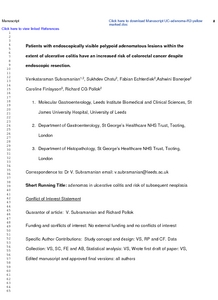Subramanian, V; Chatu, S; Echterdiek, F; Banerjee, A; Finlayson, C; Pollok, RCG
(2016)
Patients with Endoscopically Visible Polypoid Adenomatous Lesions Within the Extent of Ulcerative Colitis Have an Increased Risk of Colorectal Cancer Despite Endoscopic Resection.
Dig Dis Sci, 61 (10).
pp. 3031-3036.
ISSN 1573-2568
https://doi.org/10.1007/s10620-016-4246-7
SGUL Authors: Pollok, Richard Charles G
![[img]](https://openaccess.sgul.ac.uk/109403/7.hassmallThumbnailVersion/DDSJ-D-15-01847_R1%20reviewer%20comments%20removed.pdf)  Preview |
|
PDF
Accepted Version
Available under License ["licenses_description_publisher" not defined].
Download (1MB)
| Preview
|
Abstract
OBJECTIVES: Ulcerative colitis (UC) is associated with an increased risk of colorectal cancer (CRC). Few studies have looked at long-term outcomes of endoscopically visible adenomatous lesions removed by endoscopic resection in these patients. We aimed to assess the risk of developing CRC in UC patients with adenomatous lesions that develop within the segment of colitis compared to the remainder of an ulcerative colitis cohort. METHODS: We identified patients with a confirmed histological diagnosis of UC from 1991 to 2004 and noted outcomes till June 2011. The Kaplan-Meier method was used to estimate cumulative probability of subsequent CRC. Factors associated with risk of CRC were assessed in a Cox proportional hazards model. RESULTS: Twenty-nine of 301 patients with UC had adenomatous lesions noted within the segment of colitis. The crude incidence rate of developing colon cancer in patients with UC was 2.45 (95 % CI 1.06-4.83) per 1000 PYD and in those with UC and polypoid adenomas within the extent of inflammation was 11.07 (95 % CI 3.59-25.83) per 1000 PYD. Adjusted hazards ratio of developing CRC on follow-up in UC patients with polypoid dysplastic adenomatous lesions within the extent of inflammation was 4.0 (95 % CI 1.3-12.4). CONCLUSIONS: The risk of developing CRC is significantly higher in UC patients with polypoid adenomatous lesions, within the extent of inflammation, despite endoscopic resection. Patients and physicians should take the increased risk into consideration during follow-up of these patients.
| Item Type: |
Article
|
| Additional Information: |
This is a post-peer-review, pre-copyedit version of an article published in Digestive Diseases and Sciences. The final authenticated version is available online at: http://dx.doi.org/10.1007/s10620-016-4246-7 |
| Keywords: |
Adenomas, Cancer, Dysplasia, Risk, Ulcerative colitis, Adenocarcinoma, Adenoma, Adult, Aged, Carcinoma, Colitis, Ulcerative, Colon, Colonic Polyps, Colonoscopy, Colorectal Neoplasms, Female, Humans, Male, Middle Aged, Proportional Hazards Models, Retrospective Studies, Risk, Adenomas, Cancer, Dysplasia, Risk, Ulcerative colitis, Gastroenterology & Hepatology, 1103 Clinical Sciences |
| SGUL Research Institute / Research Centre: |
Academic Structure > Infection and Immunity Research Institute (INII) |
| Journal or Publication Title: |
Dig Dis Sci |
| ISSN: |
1573-2568 |
| Language: |
eng |
| Dates: |
| Date | Event |
|---|
| October 2016 | Published | | 12 July 2016 | Published Online | | 4 July 2016 | Accepted |
|
| Publisher License: |
Publisher's own licence |
| PubMed ID: |
27405991 |
| Web of Science ID: |
WOS:000384211900034 |
 |
Go to PubMed abstract |
| URI: |
https://openaccess.sgul.ac.uk/id/eprint/109403 |
| Publisher's version: |
https://doi.org/10.1007/s10620-016-4246-7 |
Statistics
Item downloaded times since 19 Dec 2017.
Actions (login required)
 |
Edit Item |



